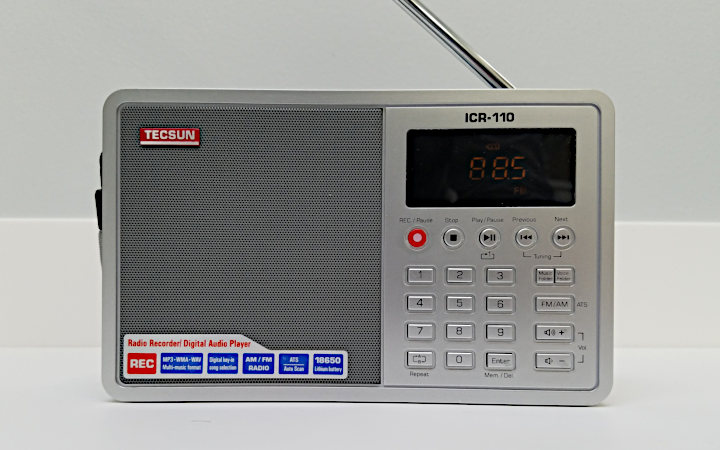
Is it a DSP (Digital Signal Processing) radio, or isn't it? The Tecsun ICR-110 has actually been available since 2014, judging by this article at The SWLing Post. However, until 2019 or so, it was available only in a version intended for the Chinese domestic market, complete with labeling in Chinese characters. Finally, a version for export was released, with labels and a manual in English. I bought mine in 2020 for $40 from Amazon.
Tecsun doesn't claim that the ICR-110 uses DSP. Yet one reviewer claims that it is. As with the related Tecsun model ICR-100, the owner's manual is silent on the matter.
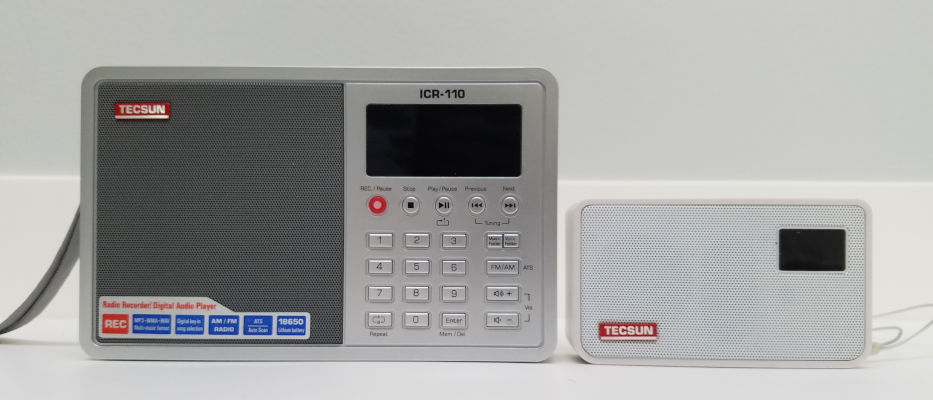
The ICR-110's capabilities are similar to those of the ICR-100, including a media player and MP3 recorder, with the addition of AM radio reception. The ICR-110 is quite a bit larger than the ICR-100, as shown above, with the ICR-110 on the left and the ICR-100 on the right.
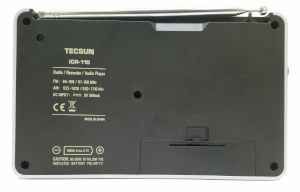
The ICR-110 uses a rechargeable 3.7-volt 18650 lithium-ion battery, supplied with the device. Such a battery is not a plus in my book, given all the issues that I've had with it in the XHDATA D-808. After six months of use, though, I can say that the Tecsun ICR-110 has been trouble-free, with the battery retaining its charge when not in use, and not needing frequent recharging even when idle (which is a problem with the XHDATA D-808).
Of course, lithium-ion batteries have other challenges. They can't be placed in checked baggage on an airplane, for example. While they pack a lot of energy for their weight (and the ICR-110 is surprisingly light for a radio its size), they also can be volatile and have to be handled with care. For rechargeable batteries, I much prefer metal-hydride batteries, which don't suffer from these problems and which come in the same standard sizes as alkaline batteries. Tecsun supports the use of metal-hydride or standard alkaline batteries in many of its other radios. Without being able to examine circuit diagrams, I can only speculate that Tecsun is using lithium-ion batteries primarily where a stronger audio amplifier is employed. Certainly, Tecsun has a good reputation for quality control, which appears to extend to the batteries that it's using. Even so, I would have preferred something different.
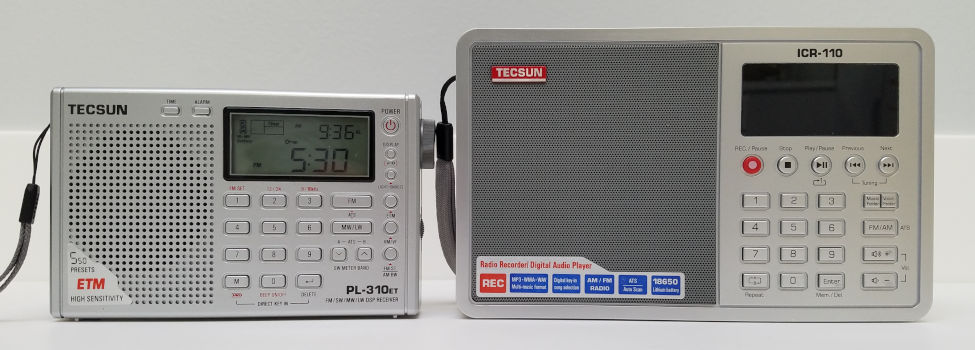
The ICR-110 is also bigger than the travel portables that comprise much of Tecsun's line-up, such as the PL-310ET (on the left in the photo above). The speaker is bigger too, resulting in much better sound. The specifications for the ICR-110 claim it has a 3-watt audio amplifier, unusually beefy for a portable radio of this size. The sound is definitely richer than any of the Tecsun travel portables, and as powerful as its relative, the ICR-100.
The ICR-110 has more flexibility in tuning stations compared to the ICR-100. Unlike the ICR-100, the ICR-110 makes it possible to tune a station by entering its frequency directly, using the numeric keypad on the front of the radio. (The ICR-100 lacks a numeric keypad.) The "left" and "right" tuning buttons, which are repurposed with the media player, tune across memory positions. Stations can be stored into memory through an automatic scan, or manually.
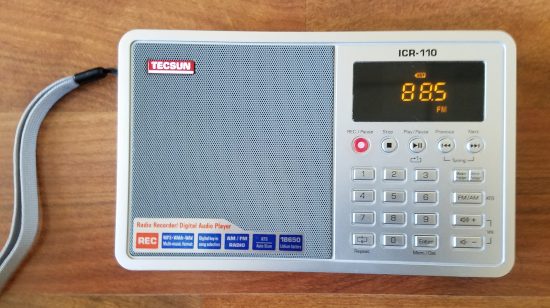
The ICR-110 tunes the AM (mediumwave) and FM bands. It doesn't tune shortwave stations. The frequency display uses LEDs rather than LCDs, making it difficult to photograph. The picture on the left was taken in lower-light conditions so that the display would show more clearly. In bright light, the display washes out, as you may notice from some of the other photos.
Just like the ICR-100, turning on the radio takes a couple of seconds. During that time, HI is shown on the display. The battery-charging display isn't fine-grained: it either shows as full or one-third full.
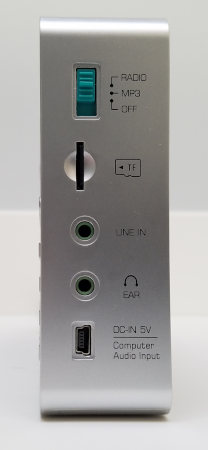
On the right side of the radio (shown at right) is a three-position switch, for selecting between the radio and the MP3 player or to turn off the unit altogether. There's a slot for a micro-SD card of up to 32 GB capacity, used for the media player and recorder. There's a 3.5mm stereo line-in jack that can be used either to listen directly to another device, or for recording. Below it is a standard 3.5mm stereo headphone jack (FM stereo listening is available only through headphones), and an increasingly uncommon standard mini (not micro) USB port for battery charging. The USB port can also serve as an audio input for use by a computer. There's a lot of flexibility there!
Because this is a much larger unit than the ICR-100, the FM antenna is an extendible rod, rather than the wrist strap that the ICR-100 uses. In theory, at least, this should provide better results for FM reception. The antenna is too short, an extremely common occurrence with Chinese models: it should be 30 inches, but the ICR-110's antenna extends only 25 inches (63.5 cm). The AM antenna is built into the unit, as usual.
FM reception
One afternoon in July 2020 at my San Francisco Bay Area location, I conducted a head-to-head comparison of FM reception with the Tecsun PL-380, which is one of the best FM performers for small-sized or travel-sized radios. (Note that it also has an undersized FM antenna.) I also compared the ICR-110 to the Tivdio V-115, a radio that also has media recording and playback capabilities.
The three radios received the following number of FM stations:
- Tecsun ICR-110: 43 stations
- Tecsun PL-380: 52 stations
- Tivdio V-115: 43 stations
Even though the ICR-110's performance, based on raw station counts, appeared to be the same as the Tivdio V-115's count, there were notable differences:
- The ICR-110 has a wider reception bandwidth compared to the other radios. A few weak signals that could be received on the PL-380 could not be received on the ICR-110 simply because they were too close to strong local stations.
- The Tivdio unit had a narrower bandwidth but was not as sensitive as the Tecsun ICR-110.
- The ICR-110 also had a lower threshold for stereo reception than the others. Therefore, it could receive more stations in stereo compared even to the PL-380:
- Tecsun ICR-110: 40 stations in stereo
- Tecsun PL-380: 39 stations in stereo
- Tivdio V-115: 33 stations in stereo
My subjective observation is that the ICR-110 has better audio quality and better stereo separation when listening with headphones than the PL-380.
AM reception and audio quality
The same radios were used to compare AM reception. Only the Tecsun PL-380 had multiple reception bandwidths available. For this test, a bandwidth of 4 kHz was used on the PL-380. This was roughly comparable to the bandwidth available in the other two units.
Results:
- Tecsun ICR-110: 35 stations
- Tecsun PL-380: 35 stations
- Tivdio V-115: 26 stations
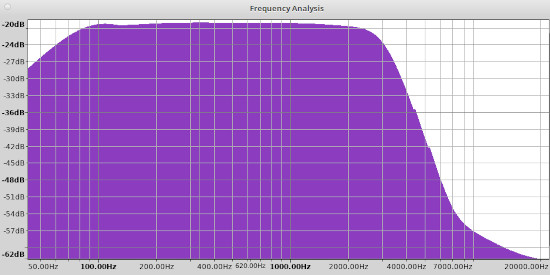
There was a lot of electrical interference on the AM band that day, making it difficult to interpret these results. It did seem that the PL-380 was less subject to interference than the ICR-110. It also seemed that the PL-380 was a bit more sensitive than the ICR-110. Neither one was able to pick up KSRO (1350 kHz) from Santa Rosa, which was surprising. Again, that could just have been problems with interference on the dial. The Tecsun units far outclassed the Tivdio V-115 for AM reception.
Unlike most DSP-based radios, the ICR-110 does not have a selectable audio bandwidth on AM. This is another reason I doubt that the ICR-110 is using DSP. A frequency sweep (displayed at left)shows that upper frequency response is down 6 dB at 3.3 kHz and down 21 dB at 5 kHz. While this is a fairly sharp curve, the radio itself still has a fairly pleasant sound when listening to AM broadcasts.
The AM response curve is very smooth, which actually is a characteristic of DSP-based radios. Audio distortion is very low on both AM and FM, contributing to the pleasant nature of the radio's sound.
The drop in frequency response below 100 Hz appears to be an artifact of the software program that I used both to generate the sweep tone and to analyze the results. I believe it can be disregarded, because it consistently appears on the graphs that I've made with the program.
Media player and recorder
The media playback and recording capabilities of the ICR-110 are nearly identical to the Tecsun ICR-100. Most limitations are also shared with the ICR-100. The numeric keypad does add one advantage: when playing music files from the micro-SD card in the ICR-110, you can address the track by number. That's not much of an advantage over the ICR-100, but it might be easier than continually pressing the "previous" or "next" buttons if you have a rough idea of how many tracks you have on the card.
As with the ICR-100, the ICR-110's recording function only records in the MP3 format, and while it uses a reasonable bit rate of 128 kbps, the sample rate is 32 kHz instead of a more standard 44.1 kHz, putting an upper bound on the frequency response. For most applications, that would not present a notable problem. However, as with the ICR-100, a low-pass "brickwall" filter is employed to limit upper frequency response to around 10 kHz (see more details and graphs in the Tecsun ICR-100 review). The brickwall filter is applied to recordings made from the line input as well as recordings made from the radio. The only source for which quality wouldn't be affected by this filter is the AM radio. As I mention in the ICR-100 review, this filter is entirely unnecessary, causing lower-quality recordings than otherwise would have been possible.
The issue with residual noise in the ICR-110 is also present in the ICR-100. While at a low level, that noise still may have an adverse effect on the quality of some recordings. These limitations are very unfortunate, limiting the device's usefulness for making recordings to situations where either convenience is paramount, or where quality may not matter so much. It definitely can't be used for professional-quality recordings.
Conclusion
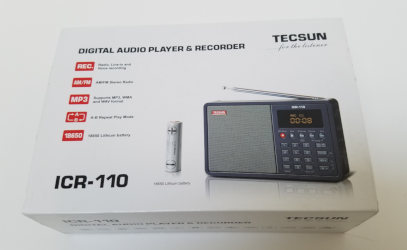
My belief is that, for the ICR series of devices, Tecsun prioritized sound quality over reception capability. It turns out that there wasn't much difference on AM, but some difference on FM. The ICR-110 sounds better, but the PL-380 (or its DSP-based siblings) will get more stations. It is unfortunately that the same attention to sound quality didn't extend to the unit's recording capabilities. The brickwall filter is a bad idea and makes the ICR-110 less useful than it should be. The Tivdio V-115 is actually a better, and more flexible, recorder and playback device. As a radio, I'm somewhat satisfied with the ICR-110, but I wouldn't go out of my way to get another one.
And, just to answer the question at the top of this page, no, I don't think it's a DSP-based radio.